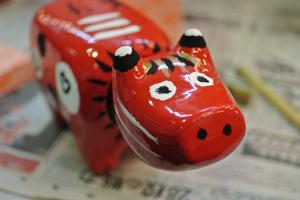| JET Study Tour Oct,2015 Member's Report10 | Name: Khiet Nguyen(USA) |
|---|---|
I think everyone who received a placement in Fukushima experienced a moment of concern about his or her safety. The way that the media portrayed this region in 2011 has left a formidable negative image of Fukushima as a nuclear wasteland. Though I realized that this could not be the case and did the proper research to confirm that, I still had doubts. Upon arriving here, I have not only felt safe based on empirical evidence—the levels of radiation are no different than where I lived in the United States—but I have felt an immeasurable sense of ease knowing how diligently people in this area work to ensure public safety. Our first stops on the tour were to two food safety testing facilities: one that handled a variety of agricultural products from Fukushima, and one that exclusively tested rice. The food safety standards regarding acceptable levels of radiation in Japan are several times more strict than in the US or EU. Every bag of rice, including those packaged for sale, kept for personal consumption by farmers, and used for any sort of manufacturing of goods, must comply with these standards. Moreover, at this facility in Inawashiro, each 30kg bag of rice is lifted onto a conveyor belt and tested individually. An employee marks each bag with a unique barcode. Once scanned, this barcode gives the customer access to the safety statistics about the specific bag of rice that he or she intends to buy. This is a slow, painstaking, and completely transparent process done not only to ensure the safety of the consumer, but to ensure the safety of the producer. We also learned about several functioning and thriving renewable energy plants in the Aizu region. I was especially impressed with the initiative in Aizuwakamatsu. Considerable portions of the city, including a brewery, run on solar energy. Even more impressively, this solar energy plant was founded as a local entrepreneurial venture and is operated by local residents who work in a variety of fields. This exploration of renewable power sources is especially prudent considering not only the desire for safer alternatives to nuclear energy, but it is also an excellent example of public environmental consciousness. On top of the informative, more academic portions of the tour, we also experienced some of the most famous Aizu sights and specialties. The Aizu region was largely unaffected by the 2011 disaster, and seems to have suffered more from the decline in tourism. Many of the spots we visited, including Tsuruga Castle and Ouchijuku, a reconstruction of an Edo period town, seemed too empty given that it was a holiday weekend. This is a shame, as there is so much to see. The natural beauty of this region, especially in the fall when we went, is absolutely breathtaking and is steeped in so much history. Having moved from the US, I am fascinated by living in a place where structures and traditions cultivated during modernity cohabitate with those that are centuries old. I especially enjoyed visiting Enzoji Temple in Yanaizu, the supposed birthplace of the Akabeko. I feel lucky to have gone on this tour, as I don’t think I would have been able to squeeze so many stops in one weekend on my own. I hope that my experience makes my friends and family want to visit Japan and Fukushima, and I hope that they are as captivated by it as I have become.
| |
| Back to tour's summary |








